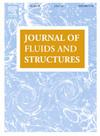Numerical investigations on wake transition of a 2-DOF elastically mounted circular cylinder
IF 3.4
2区 工程技术
Q1 ENGINEERING, MECHANICAL
引用次数: 0
Abstract
Present is a three-dimensional (3D) numerical study on vortex-induced vibration (VIV) of an elastically mounted rigid circular cylinder in cross-flow. The cylinder motion has two degrees-of-freedom (2-DOFs), i.e. it can oscillate in both streamwise as well as in transverse directions. The open-source software, ‘OpenFOAM-7′ (Open Field Operation and Manipulation), has been used to solve the governing equations of fluid and cylinder motion. Computations are carried out to investigate the behavior of wake transition from two-dimension to three-dimension (2D to 3D) and the associated flow characteristics over range of values of reduced velocity (Ur), Reynolds number (Re) and mass ratio (m*). In particular, the range of Ur (2 ≤ Ur ≤ 10) encompasses both lock-in and non-lock-in regimes, where lock-in refers to synchronous oscillations of the cylinder and the wake. Effect of Ur on unsteady wake has been examined using vorticity contours and iso-Q surfaces. The temporal behavior of both the cylinder and wake oscillations has been analyzed using Hilbert spectra. The critical value of Re () for transition from 2D to 3D through ‘mode C’ type of instability is ascertained for fixed values of m* and Ur. Thereafter, the critical values of m* and Re are obtained by considering their mutual variation for fixed Ur and the associated mode transition is identified. At small values of m*, ‘mode C’ type of instability appears which changes to ‘mode A’ type for larger m*.
二自由度弹性圆柱尾迹过渡的数值研究
本文对横向流动中弹性安装刚性圆柱涡激振动进行了三维数值研究。圆柱运动有两个自由度(2-DOFs),即它可以在两个流向以及在横向方向振荡。开源软件“OpenFOAM-7”(Open Field Operation and Manipulation)已被用于求解流体和圆柱体运动的控制方程。计算研究了从二维到三维(从二维到三维)的尾迹过渡行为以及在降速(Ur)、雷诺数(Re)和质量比(m*)值范围内的相关流动特性。特别地,Ur(2≤Ur≤10)的范围包括锁定和非锁定状态,其中锁定指的是圆柱体和尾迹的同步振荡。利用涡度曲线和等q曲面研究了Ur对非定常尾迹的影响。用希尔伯特谱分析了圆柱和尾流振荡的时间特性。对于固定的m*和Ur值,确定了Re (Recr)通过“C模式”型不稳定性从2D过渡到3D的临界值。然后,考虑固定Ur时m*和Re的相互变化,得到了它们的临界值,并识别了相应的模态跃迁。当m*较小时,出现“C型”失稳,当m*较大时,出现“A型”失稳。
本文章由计算机程序翻译,如有差异,请以英文原文为准。
求助全文
约1分钟内获得全文
求助全文
来源期刊

Journal of Fluids and Structures
工程技术-工程:机械
CiteScore
6.90
自引率
8.30%
发文量
173
审稿时长
65 days
期刊介绍:
The Journal of Fluids and Structures serves as a focal point and a forum for the exchange of ideas, for the many kinds of specialists and practitioners concerned with fluid–structure interactions and the dynamics of systems related thereto, in any field. One of its aims is to foster the cross–fertilization of ideas, methods and techniques in the various disciplines involved.
The journal publishes papers that present original and significant contributions on all aspects of the mechanical interactions between fluids and solids, regardless of scale.
 求助内容:
求助内容: 应助结果提醒方式:
应助结果提醒方式:


